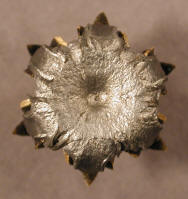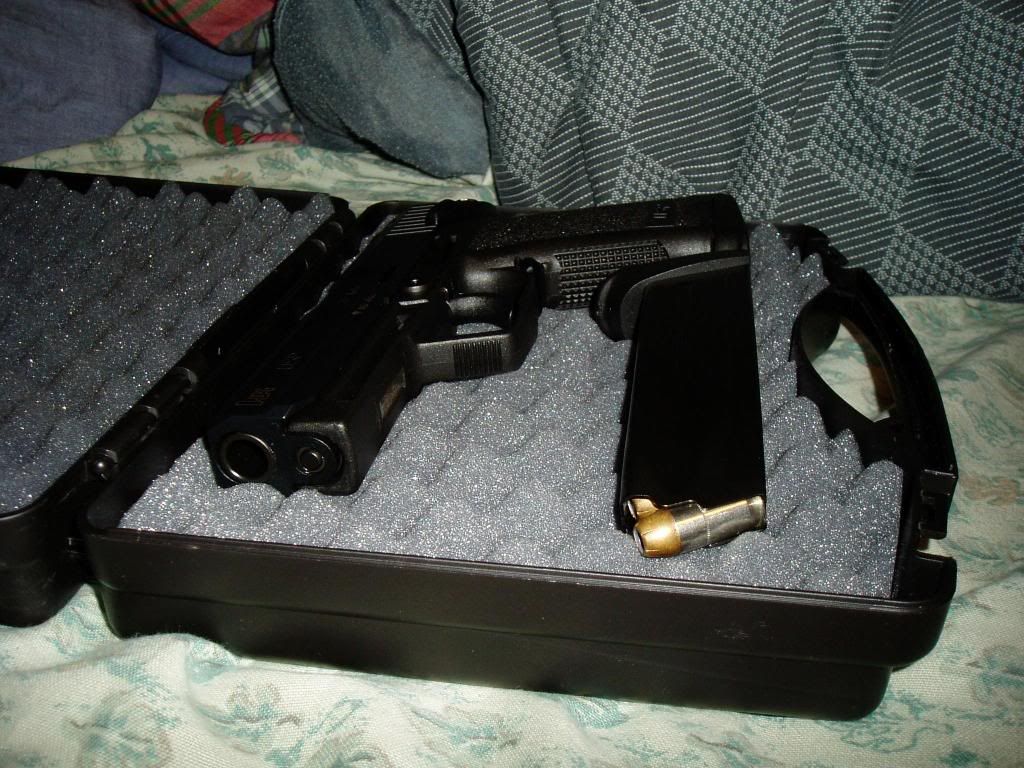http://www.le.atk.com/pdf/Pierce%20County%20Workshop.pdfThis is a pretty good file on hollowpoint penetration, looks like the Federal hydrashoks rank up there which is what i'm using myself. I also have some black talons but I haven't shot them (they are a novelty item since they were banned from shelves)
Don't let that liberal mindset get to anyone that they refer to hollowpoints as "cop killers".
Unfortunately I believe the hollowpoints are banned for use in war because they were considered "cruel"
Odd because in hunting, your required in most cases to use hollowpoints or expanding ammo.
Here are the benefits of a hollowpoint opposed to a full metal jacket round
When the bullet strikes a soft target the pressure created in the pit forces the material (usually lead) around the inside edge to expand outward, increasing the axial diameter of the projectile as it passes through. This process is commonly referred to as
mushrooming, because the resulting shape, a widened, rounded nose on top of a cylinderical base, sometimes resembles a
mushroom.
The greater frontal surface area of the expanded bullet limits penetration into the target, and causes more tissue damage along the wound path. Many hollow point bullets, especially those intended for use at high velocity, are partially
jacketed, that is, a portion of the lead bullet wrapped in a thin layer of harder metal, such as
copper or mild
steel. This jacket provides additional strength to the bullet, and can help prevent the bullet from leaving deposits of metal inside the bore. In
controlled expansion bullets, the jacket helps to prevent the bullet from breaking apart. A fragmented bullet will generally not penetrate to the desired depth.
Terminal ballistics testing of hollow point bullets is generally performed in
ballistic gelatin, or some other medium intended to simulate tissue and cause a hollow point bullet to expand. Test results are generally given in terms of expanded diameter, penetration depth, and weight retention. Expanded diameter is an indication of the size of the wound cavity, penetration depth shows if vital organs could be reached by the bullet, and weight retention indicates how much of the bullet mass fragmented and separated from the main body of the bullet. How these different factors are interpreted is subject to to intended use of the bullet, and what constitutes "good" or "bad" performance is subject to disagreement.
Now then I don't know where hollowpoints are legal or not. I don't know if they are legal in Israel, I do know that they are banned in certain areas of the US (not in my state).
The
Hague Convention of
1899, Declaration III, prohibits the use in warfare of bullets which easily expand or flatten in the body. This is often incorrectly believed to be prohibited in the
Geneva Conventions, but it significantly predates those conventions, and is in fact a continuance of The
Declaration of St Petersburg in
1868, which banned exploding projectiles of less than 400 grams, and weapons designed to aggravate injured soldiers or make their death inevitable. Despite the ban on military use, hollow point bullets are one of the most common types of civilian and
police ammunition, due largely to the reduced risk of bystanders being hit by over-penetrating or ricocheted bullets, and the increased speed of incapacitation. In many
jurisdictions, it is illegal to
hunt game with ammunition that
does not expand, and some target ranges also forbid
full metal jacket ammunition.
Regarding hollowpoint expansion
http://www.allsafedefense.com/Special_Pages/BulletTest.htm These are the black talons
The Winchester "Law Enforcement line" work consistently well. The .40's on the right are the old "Black Talon" (now the politically-correct SXT). All calibers stayed together and stayed in the phone books. Obviously the cop ammo is made to significantly higher specs than the civilian fodder.
Note expansion


standard black talon (banned by color and name only)

Black talon controversy (its a load of bull****, really)
In the early
1992 Winchester introduced a newly designed hollow point handgun bullet which used a specially designed, reverse tapered jacket. The jacket was cut at the hollow to intentionally weaken it, and these cuts allowed the jacket to open into six petals upon impact. The thick jacket material kept the tips of the jacket from bending as easily as a normal thickness jacket. The slits that weakened the jacket left triangular shapes in the tip of the jacket, and these triangular sections of jacket would end up pointing out after expanson, leading to the "Talon" name. The bullets were coated with a black colored, paint-like lubricant called "Lubalox," and loaded into nickel-plated brass cases, which made them visually stand out from other defensive ammunition. While actual performance of the Black Talon rounds was not significantly better than any other comparable high performance hollow point ammunition, the reverse taper jacket did provide reliable expansion under a wide range of conditions, and many police departments adopted the round.
Winchester's "Black Talon" product name was eventually used against them. After a high profile shooting at
101 California Street in
1993, media response against Winchester was brutal. "This bullet kills you better", says one report; "its six razorlike claws unfold on impact, expanding to nearly three times the bullet's diameter, "
[1] a gross exaggeration of the actual performance
[2]. A concern was raised by the American College of Emergency Physicians, that the sharp edges of the jacket could penetrate surgical gloves, and increase the risk of blood borne infections being transmitted to medical personnel treating the gunshot wound. While possible, there are no recorded cases of such an infection occurring in relation to the Black Talon bullets
[3].
Winchester responded to the media attacks on the Black Talon line by pulling it from their civilian marketing channels, and selling it only through Winchester law enforcement distributors. They also discontinued applying the black Lubalox coating and renamed the line "Ranger SXT." The rounded edges had no function effect on the terminal performance, but addressed the ACEP's concerns about possible dangers to medical personnel.
Even though Winchester voluntarily pulled Black Talon from the civilian market, they were subsequently sued for another 1993 shooting, this one in
New York, involving Black Talon ammunition. The suit claimed "negligent manufacture, advertising and marketing of a product that was unreasonably designed and ultrahazardous." However, the court found that "The very purpose of the Black Talon bullet is to kill or cause severe wounding. Here, plaintiffs concede that the Black Talons performed precisely as intended by the manufacturer".
[4] Since the bullet was designed to cause rapid incapacitation, and since it performed as expected, the lawsuit was dismissed.
See federal hydrashok expansion

I was surprised that several of the Hydra-Shoks blew up in the top few inches of the phone books. Then we tried them with shorter barrels and they seem to hold together a lot better. You can see the little post remain in the expended rounds. Last year I removed the post with a Dremel tool and the round didn't open up at ALL! An important design feature! Lesson learned: Federal HydraShoks are most effective out of barrels less than three inches.
You'll notice the grooves on the bullet, also in the center there is a rod which I believe helps to inflict more damage

you can see the rod in this picture


The hydrashoks are what I use for my nightstand gun (my USP)
I have yet to shoot this stuff at the range, I want to get some ballistic gel and see it's effectiveness for my own eyes however, for those who have shot hollowpoints, what was your experience with that brand?